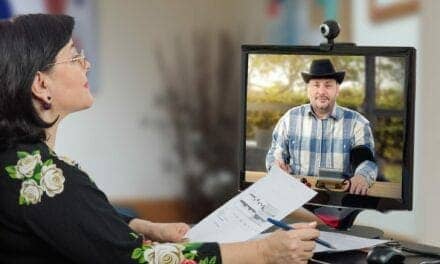Spurred by the pandemic, dentists, oral appliance makers, and home medical equipment companies find ways to minimize or eliminate patient contact. But some caution these delivery methods also eliminate the touchpoints required for optimal therapy.
By Kristen Fischer
Telemedicine has soared during the COVID-19 pandemic, and the dental community is no exception. Patients may not be able to avoid the office chair for services like cavity fillings, but some are minimizing trips to the dentist’s office for oral appliances for obstructive sleep apnea (OSA)—by having impressions and fitting done from their own homes. While some professionals say at-home dentist-supervised oral appliance fitting is a savvy way to increase therapy access, others say skipping in-office visits could mean patients miss out on key aspects of care that can only be provided in person.
Traditionally, a sleep physician writes a patient with OSA a prescription for an oral appliance, then the patient goes to a dentist in person, usually several times: to assess oral fitness, have impressions taken, ensure the device fits, undergo adjustments for efficacy or comfort, and ultimately for ongoing therapy management for the duration of their treatment. Much precision goes into the process, as finding the best setting can come down to millimeters to get the apnea-hypopnea index to a level the sleep physician deems therapeutic. Sometimes a patient has to return to the dentist multiple times to calibrate it perfectly.
David Schwartz, DDS, president of the American Academy of Dental Sleep Medicine (AADSM), says virtual appointments should only be used if they can provide a similar level of care as an in-person visit. “Whether a qualified dentist can provide a similar level of care for virtual oral appliance fittings depends on a multitude of factors that include the telemedicine system, the patient, the dentist, and the appliance,” he says.
He advises that dentists follow practice guidelines, available at www.aadsm.org/guidelines.php, and assess whether virtual appointments are appropriate based on the needs of each patient.
Sleep physician Richard Bogan, MD, FCCP, FAASM, found that transitioning to telehealth delivery of oral appliance therapy has worked well for his patients during the pandemic. “From my perspective, virtual care in select patients was no less effective than in-person visits with the dentist,” he says. Bogan, principal owner at Bogan Sleep Consultants in Columbia, SC, and a member of the medical technology advisory board for Oventus Medical, has had success starting patients on Oventus’ O2Vent Optima without in-person visits. “I like the integrated airway technology, and the 3-D designed and printed device provides the likelihood of a more accurate fit,” Bogan says. “There are no screw advancements, no metal hinges to contend with, and patients can easily change the straps for adjustments as instructed by the dentist.”
In addition to the Oventus Medical device, dentists and patients who opt for a virtual route have several new options.
Shifting Care Delivery
During initial COVID-19 lockdowns, Steve Carstensen, DDS, a dentist specializing in oral appliance therapy at Premier Sleep Associates in Washington state and director of clinical education at Airway Management Inc, tried to minimize patient interaction.
He saw patients in the office who had been in the process of getting an oral appliance. He also worked out a protocol to provide interim Airway Management myTAP devices to those who were reluctant to use a CPAP and/or wanted to treat known breathing problems but could not arrange doctor visits. Because myTAP uses a liner that can be reheated and refit if needed, it allows for a fitting to be done at home. “We recorded self-fit videos and offered telehealth coaching to provide care,” Carstensen says.
For an oral appliance fitting, Carstensen usually sees patients twice. First, the patient comes in for an exam where Carstensen goes over their records and discusses product options. Then he sees patients for a fitting. He uses telehealth for any additional visits after that but those are rarely needed. “With today’s accurately made oral appliances, there is rarely a need for additional adjustment visits, so all our follow-up is done via telehealth,” Carstensen says.
That said, he is “not yet” pursuing virtual fittings actively—only if a patient needs or requests it.
“There is so much instruction that must go into proper treatment with [oral appliance therapy] that the personal connection is necessary, we think,” he says. “If a person insisted on a virtual fitting, we would make that happen. It would limit the choice of device to ones that are predictably ‘easy delivery’ or can be modified in small ways at home by the patient.”
At-Home Impressions Pilot
In December 2020, Dental Sleep Care Alliance unveiled a way for sleep apnea patients to obtain at-home impressions and deliver the Oventus O2Vent Optima patient-matched oral appliances. In February 2021, the pilot program became accessible to dentists and patients via GoPAPfree, a direct-to-patient marketing site. Oventus CEO Chris Hart, MPhil, Bsc, BDSc, has experience providing dental services to remote mining towns in Australia, when he owned and operated dental clinics in Queensland—so he was in a strong position to develop the Oventus pilot.
“One of our goals is to be able to reach patients who otherwise would be in a dental sleep ‘desert’ with limited access to needed oral appliance services and treatment,” Hart says. “Also, to place the patient in the center of care…If there is a way to provide oral appliances that require minimal adjustments, lower costs that are related to bricks-and-mortar care, and that can be managed in the safety and comfort of a patient’s home, then we should offer that choice.”
A registered dental assistant or hygienist performs the patient intake and schedules the teledentistry appointment before the Oventus impression kit arrives via mail at the patient’s house. The dental support person also determines whether the patient is dentally fit to move forward (such as by requesting dental x-rays). If approved, the dentist then virtually guides the patient through an assessment and impression-taking, says Lisa Shanks, RDA, dental sleep practice coordinator at Oventus.
The patient mails the impressions to the lab and receives their 3D-printed device in return. The device comes with a full range of 1mm band lengths so it can be fitted and adjusted with instructions provided from the attending dentist. The patient is also provided with morning exercise instructions, as they would be if they received their device in a dental office.
If a patient is not a telemedicine candidate or they prefer an in-person scan, Oventus will direct the patient to a qualified dentist, Shanks says. The referring sleep physician is updated routinely with the patient’s progress either way, she adds.
“Everything has its advantages and disadvantages,” Hart says. “We have refined this virtual model to make it a win-win for getting patients into care when they need it despite the pandemic.”
Potential Perils of Virtual Models
Valerie Barba, DDS, a general and cosmetic dentist in New Jersey who also fits oral appliances, says in her view, oral appliances for sleep apnea require in-person care. “It’s just impossible to take out that direct support from the professional,” she says, noting that measurements, an intraoral scan, and a range-of-motion evaluation are required.
After the device is made, the patient has to be monitored to ensure a proper fit. Follow-up care may not have to be done in person, Barbra says.
A potential danger of patients not seeing a dentist in-person is if they, potentially unknowingly, have preexisting periodontal disease, jaw dysfunction, or decay. If not addressed up front, these problems can worsen with oral appliance therapy.
To address this issue, Oventus representatives say the company requires a waiver of dental fitness from the patient’s general dentist and/or dental x-rays taken within the last 6 months.
There are also concerns about therapy adherence, particularly since some patients try oral appliances specifically because they were not adherent to CPAP.
Carstensen says, “Most patients have a bit of discomfort during the accommodation period. Without a professional’s support, the patient may abandon oral appliance therapy early, perhaps leaving them with no option for treating their sleep-related breathing disorder.”
There remain tens of millions of undiagnosed or untreated people and too few pathways to address that health crisis, he adds.
“While we ramp up efforts to change that, we must not lose our personal touch or devolve sleep breathing care into ‘one size fits all’ choices of therapy,” Carstensen says. “Professionals must find ways to innovate without patients losing the advantage of our specialized knowledge.”
Grant D. Hensley, DDS, vice chair of the American Academy of Sleep Medicine Dental Assembly, also has concerns about oral appliances created without in-person visits. “Most oral appliance deliveries involve at least minimal adjustments. Some need significant adjustments,” he says.
Consumers may think appliances made with boil-and-bite materials may be adequate for long-term use. “I cannot imagine being comfortable with that,” Hensley says.
For its part, Oventus has a team of oral appliance “coaches” in its pilot, who facilitate a standardized follow-up schedule: The coaches contact patients at 1 week, 30 days, and 60 days. The patient is also provided email and phone contact information so they can reach out as needed. The patient is scheduled for a follow-up with the dentist between 3 and 6 months, then annually, as well as whenever a medical issue occurs. If a dentist finds a specific fit issue, the patient receives a newly printed O2Vent Optima in about 2 weeks.
Device Limits?
Carstensen says much of the service he provides is less focused on the device and more about helping the patient choose one. “Often, their positive airway pressure experience has lacked a personal touch…we are different than that,” he says.
Choosing an appliance that lets you adjust it at home does limit a patient’s device choices, Carstensen adds.
“If a patient is getting their device remotely and starting therapy without us present, I would choose the ‘very easy’ category of device,” Carstensen says. “Similarly, if a person was reluctant to come to the office for any reason, I’m picking one my clinical experience has shown to rarely require physical adjustments.
“There’s not currently a substitute for an in-person examination to gauge whether an [oral appliance] is appropriate and to choose the best one.”
Many of his patients haven’t been successful using CPAP, so having a full selection of device choices—and going in person for care—could be their best chance at oral appliance therapy success. He still believes most people want to see their health care professionals in person when there is a physical object involved. It enables them to trust the professional’s judgement about fitting the device and gives them hands-on help with a strange device that may be confusing to them.
People will be less reluctant to come in for office visits as the world emerges from the pandemic. Even so, “telehealth will never go away,” he says.
“As our industry embraces technology that lowers the likelihood of the need for adjustments at delivery, having the patient open the box and fit their device may become more common,” Carstensen says. “It will be another way to help people ‘where they are’ instead of insisting they conform to our model.”
Kristen Fischer is a New York-based copywriter, journalist, and author. This is her first article for Sleep Review.
Photo 51530120 © Stockyimages – Dreamstime.com




